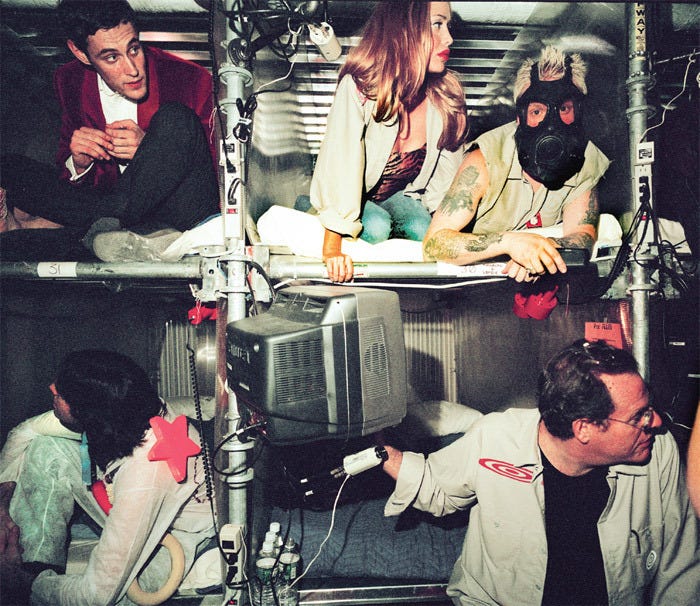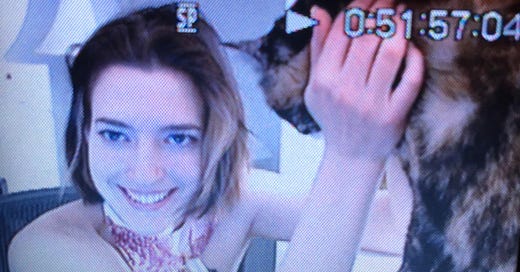“We Live in Public”, the 2009 documentary about Josh Harris, the long-lost 90s dot com prodigy, documents Harris’ Orwellian art project “Quiet: We Live in Public”.
The experiment, which took place during Manhattan’s pre-9/11 cultural heyday, placed more than 100 artists, creatives and feral club kids in a human terrarium under New York City, with myriad webcams following and capturing every move the captives made.
Harris, dubbed the Warhol of Web TV, funded and built an underground capsule hotel underneath Broadway, designed for complete surveillance. The bathrooms and showers had no walls and the buildings were wired with 150 cameras, mostly hidden. Each of the 76 sleeping pods had its own microphone, camera and TV with as many channels as pods, giving every guest audio-visual access into every moment and movement of every other “voyeur” in the building.

“We Live in Public” was designed to provide a glimpse into what the future of the internet might look like.
The project explored the concept of showing your true authentic self, long before social apps turned true authentic self™ into the ultimate, commercialized endeavour of digital communication (capture and sharing your world, the way it truly is).
In 2022, the elusive pursuit of newer and ever-rawer forms of expressing true authentic self™ continue, through increasingly aloof photo dumps of “casual Instagram” and BeReal, that enables daily front and back lens shots which capture a sometimes quirky, often mundane, “unfiltered”, off-kilter look into your reality.
But as many critics have pointed out, hidden within these acts of true authentic self™ - presented as the ultimate form of untamed and carefree self-expression - lies the greatest performance of them all.
The laissez-faire, blurry photo dumps on Instagram must be meticulously curated to achieve the sufficiently messy type of aesthetic. The 2-minute window users of BeReal have to capture their true authentic self™, in reality, involves a careful decision process of what to capture and how, and thoughtful consideration of what personal life story will eventually be woven. Like an architect, we forge our narrative from these seemingly random building blocks of images, carefully hiding the wiring and inner workings behind a faux-natural facade.
So if the selective authenticity of casual Instagram and BeReal is the greatest act of all, what does expressing true authentic self™ require?
Vulnerability.
In The Fall of Public Man (1977), sociologist Richard Sennett traced the notion of authenticity as “the involuntary disclosure of character states” to the 19th century, when the “weighting of public and private life became unbalanced.”, where publicity meant vulnerability.
For a brief time, I had Glance Back installed on my laptop, a Chrome extension that snaps a webcam photo at any random time, once a day, without permission. The results are displayed in a gallery of bleary-eyed selfies, presenting a version of my face that is so ordinary, so relaxed, or so focussed on whatever task at hand, that I barely recognize myself. It generated a sense of true, naked vulnerability, that I had never felt before. The type that bares your inner soul, without permission, and without remorse.
Your Glance Back gallery is for your eyes only - but this true sense of vulnerability could also be incorporated into the way we communicate with others. For example, Real Life magazine editor Rob Horning offered this truly authentic, soul-baring hypothetical upgrade to BeReal:
“just give your friends access to your cameras and microphones without you knowing it, so they can peep in on you and see how you act when you think no one is watching. If the panoptic gaze is falsifying us, only voyeurism sets us free.”
Total voyeurism might be able to set us free from selective authenticity, but also confines us to the arguably more problematic panoptic gaze. The price of expressing true authentic self ™ is captivity. As Josh Harris proclaims in the beginning of “We Live in Public”:
Lions and tigers used to be kings of the jungle and then one day they wound up in zoos - I suspect we're on the same track.
Harris did not bode well in digital captivity. After “Quiet: We Live in Public”, Josh announced a “We Live in Public” web project, for which he rigged up his opulent Broadway loft with dozens of cameras, committing himself and his girlfriend Tanya Corrin to "live in public" for 100 days. The pressure of 24/7 online surveillance was too much, and their relationship broke down, a blow that coincided with the last of his fortune flowing away on the stock market. He had a breakdown, and retreated to an apple farm he'd bought in upstate New York.
The selective authenticity, without the exposed nerves of our private inner lives, may not be true authentic self™. But selective authenticity does not force us to relinquish control. It gives us some authorship of our lives. Because no one ever really wants to live fully in public.






